Cape York is the northernmost point in mainland Australia. When we arrived there a few days after leaving Lizard Island, we crossed 10°40′ south, just ten degrees short of the equator. We haven’t been this far north since the Marquesas Islands in French Polynesia two years ago. And we likely won’t be again until we cross the Atlantic for the Caribbean. This completes the second phase of our triple-attraction tour of Australia, where we explore Tasmania, the Great Barrier Reef and the Kimberley, and as much of everything else we can fit in between.
Trip highlights from May 21st through May 24th follow. Click any image for a larger view, or click the position to view the location on a map. And a live map of our current route and most recent log entries always is available at http://mvdirona.com/maps
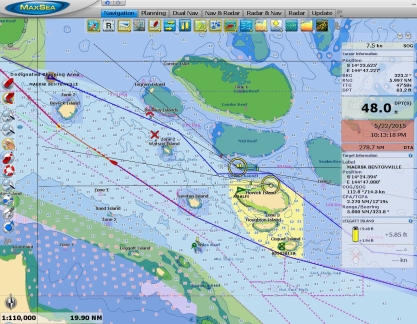 |
Maersk Bentonville
Position: 144 50.99, -14 28.49
In this part of the run north, there are two designated shipping channels. The wider one we are in is only 40-50ft deep and is too shallow for deep-draft ships. They must divert through a much tighter, but deeper, channel to the north. In the screenshot, the red boat icon and dashed line shows our position and route along the northern edge of the shipping channel. The 965-ft Maersk Bentonville, with a 43 ft draft, can be seen on AIS at the upper left. We’ve drawn in blue the route that it will follow. That sure looks tight north of Howick Island (click image for a larger view).
|
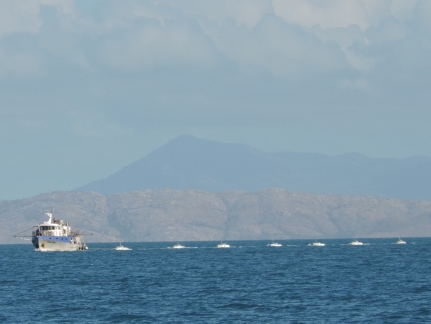 |
Ducks
Position: 144 46.96, -14 25.49
This charter boat passed, towing a string of sportsfishing tenders behind like baby ducks following a mother.
|
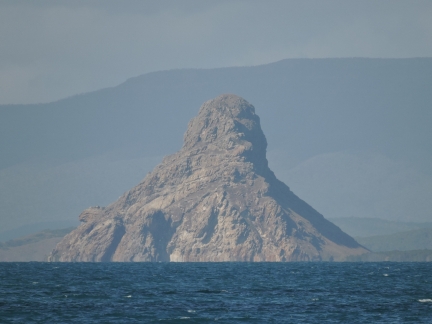 |
Noble Island
Position: 144 45.27, -14 23.91
Pyramid-shaped Nobel Island to our south as we near Barrow Point.
|
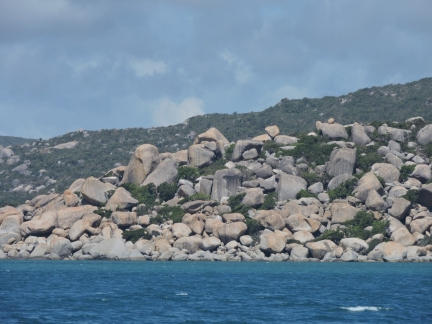 |
Cape Melville
Position: 144 30.62, -14 8.78
Smooth granite boulders, some as big as houses, are piled up along the entire headland at Cape Melville. The phenomenon is unique the Queensland Coast and one theory is that they were left by an ancient glacier.
|
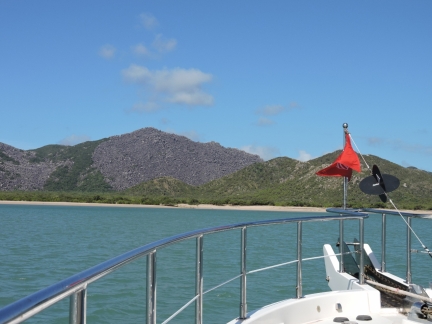 |
Bathurst Bay
Position: 144 28.23, -14 12.31
The view south to boulder-strewn Cape Melville from the anchorage in Bathurst Bay. We had good trade-wind protection here, and enjoyed our stay.
|
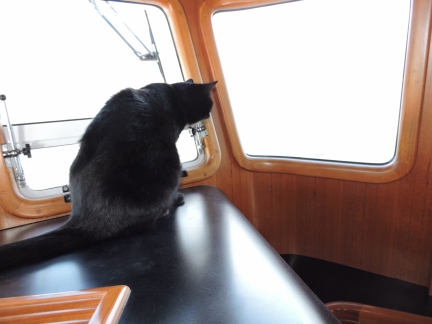 |
Under attack
Position: 144 28.22, -14 12.31
Spitfire found the anchorage at Bathurst Bay a lot less relaxing than we did. He was on alert with flocks of sparrow-like birds buzzing the boat.
|
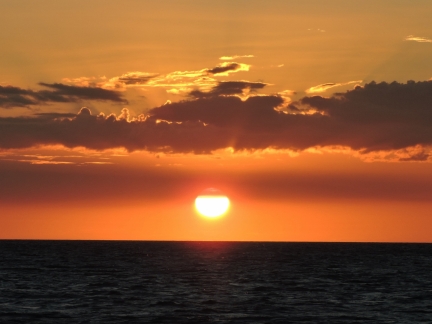 |
Sunset
Position: 144 28.22, -14 12.31
Sunset from the anchroage at Bathurst Bay.
|
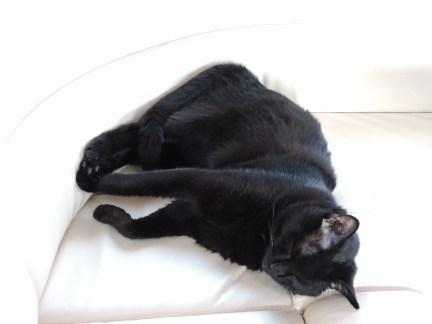 |
Underway
Position: 144 14.68, -13 53.30
Spitfire doesn’t like to slide around in the swell, so if there’s any sea running at all he’ll wedge himself against something to prevent it.
|
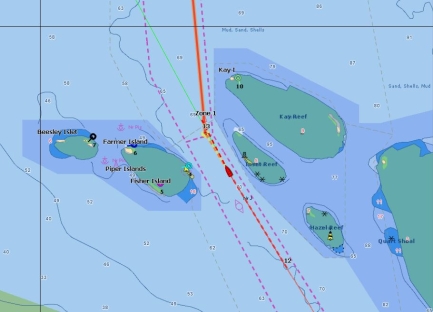 |
Tight quarters
Position: 143 15.84, -12 15.19
The shipping channels are well-marked. But especially when running at night this half-mile constriction feels surprisingly close to the lighted reefs on either side. It’s hard to believe the pilots bring 950 ft long, 105′-wide ships through this same channel.
|
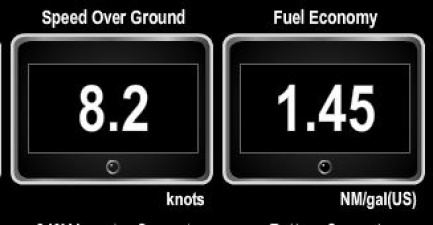 |
Speed
Position: 143 17.19, -11 56.79
We’re getting a nice push from the current and are doing 8.2 knots with a fuel economy of 1.45 miles per gallon. That combination would be especially nice on an ocean crossing–normally we’d be closer to one nautical mile per gallon at that speed.
|
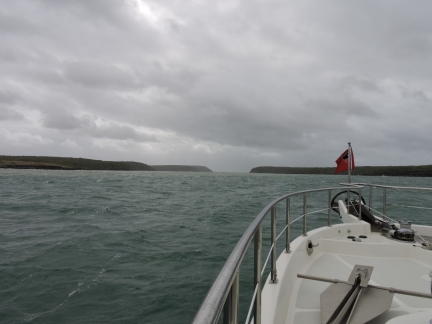 |
Albany Passage
Position: 142 37.15, -10 45.29
Entering Albany Passage between mainlaind Australia and Albany Island.
|
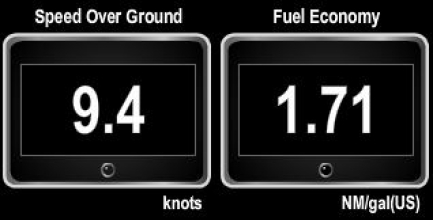 |
Current
Position: 142 36.60, -10 44.79
The current can run several knots through Albany Passage and generate steep seas in opposing. With 30-knot southeasterly winds behind us, we’d timed our arrival for low tide. The current really must whip through here as at the start of the northbound flood we’re already getting pushed along at 9.4 knots with an amazing fuel economy of 1.71 miles per gallon. The maximum speed of the boat is 9.5 knots at wide-open-throttle and at that full speed extreme, the fuel economy is only 3/4 nautical mile per gallon. So you can really see how hard we’re being pushed by current.
|
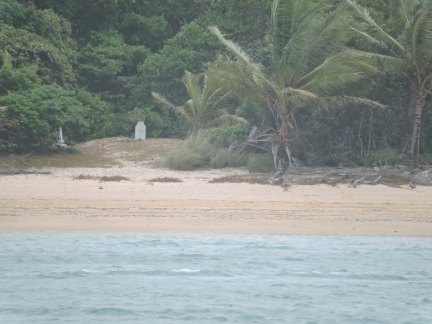 |
Somerset
Position: 142 35.84, -10 44.24
In the 1800s, Somerset was a major port and the administrative center for Cape York and Torres Strait. These moved to Thursday Island in 1877 because the swift currents in Albany Passage made for difficult anchoring and navigation. Somerset later was home to the famous Queensland pioneer Frank Jardine who is buried in this graveyard visible from the water.
|
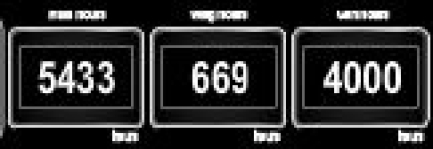 |
Engine hours
Position: 142 33.41, -10 41.61
We’ve now got 5,433 hours on the main engine, 669 on the wing and 4,000 on the generator.
|
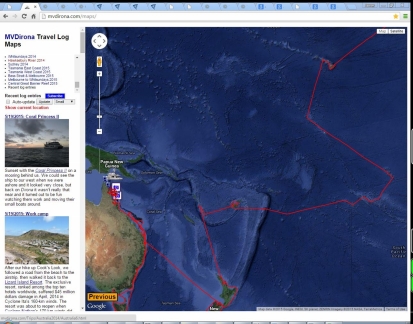 |
Milestone
Position: 142 31.87, -10 40.70
We’re at 10°40′ south–that’s just ten degrees short of the equator. We haven’t been this far north since the Marquesas Islands in French Polynesia two years ago. And we likely won’t be again until we cross the Atlantic for the Caribbean. This completes the second phase of our triple-attraction tour of Australia, where we explore Tasmania, the Great Barrier Reef and the Kimberley, and as much of everything else we can fit in between.
|
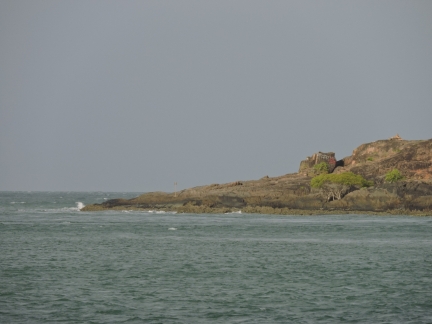 |
Cape York
Position: 142 31.45, -10 41.20
The view east from our anchorage to the tip of Cape York, the northernmost point in mainland Australia. The anchorage was scenic, with good holding and easterly swell protection. 30-40 kt gusts did reach the anchorage over the cape, but generated only small wind waves. We also considered stopping further north at Thursday Island, Australia’s northernmost port, but it is part of a special quarantine zone for food and animal products. If we stopped at any Australian island in Torres Strait, we’d need to get a permit to bring Spitfire back to mainland Australia. We definitely didn’t want anywhere near that.
|

|
Click the travel log icon on the left to see these locations on a map, with the complete log of our cruise.
On the map page, clicking on a camera or text icon will display a picture and/or log entry for that location, and clicking on the smaller icons along the route will display latitude, longitude and other navigation data for that location. And a live map of our current route and most recent log entries always is available at http://mvdirona.com/maps. |

If your comment doesn't show up right away, send us email and we'll dredge it out of the spam filter.